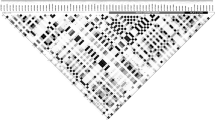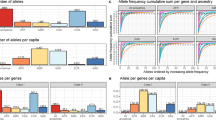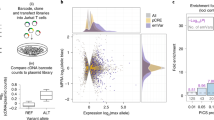Abstract
Autoimmune diseases seem to have strong genetic attributes, and are affected to some extent by shared susceptibility loci. The latter potentially amount to hundreds of candidate genes (CG), creating the need for a prioritization strategy in genetic association studies. To form such a strategy, 26 autoimmune-related CG were genotyped for a total of 72 single nucleotide polymorphisms (SNPs) in three distinct Israeli ethnic populations: Ashkenazi Jews, Sephardic Jews and Arabs. Four quantitative criteria reflecting population stratification were analyzed: allele frequencies, haplotype frequencies, the Fst statistic for homozygotes distribution and linkage disequilibrium extents. According to the consequent interpopulation genomic diversity profiles, the genes were classified into conserved, intermediate and diversified gene groups. Our results demonstrate a correlation between the biological role of autoimmune-related CG and their interpopulation diversity profiles as classified by the different analyses. Annotation analysis suggests that genes more readily influenced by environmental conditions, such as immunological mediators, are ‘population specific’. Conversely, genes showing genetic conservation across all populations are characterized by apoptotic and cleaving functions. We suggest a research strategy by which CG association studies should focus first on likely conserved gene categories, to increase the likelihood of attaining significant results and promote the development of gene-based therapies.
This is a preview of subscription content, access via your institution
Access options
Subscribe to this journal
Receive 6 digital issues and online access to articles
$119.00 per year
only $19.83 per issue
Buy this article
- Purchase on Springer Link
- Instant access to full article PDF
Prices may be subject to local taxes which are calculated during checkout






Similar content being viewed by others
References
Becker KG, Simon RM, Bailey-Wilson JE et al. Clustering of non-major histocompatibility complex susceptibility candidate loci in human autoimmune diseases. Proc Natl Acad Sci USA 1998; 95: 9979–9984.
Encinas JA, Kuchroo VK . Mapping and identification of autoimmunity genes. Curr Opin Immunol 2000; 12: 691–697.
Reboul J, Mertens C, Levillayer F et al. Cytokines in genetic susceptibility to multiple sclerosis: a candidate gene approach. French Multiple Sclerosis Genetics Group. J Neuroimmunol 2000; 102: 107–112.
Henderson RD, Bain CJ, Pender MP . The occurrence of autoimmune diseases in patients with multiple sclerosis and their families. J Clin Neurosci 2000; 7: 434–437.
Fialkow PJ, Zavala C, Nielsen R . Thyroid autoimmunity: increased frequency in relatives of insulin-dependent diabetes patients. Ann Intern Med 1975; 83: 170–176.
Salvetti M, Ristori G, Bomprezzi R, Pozzilli P, Leslie RD . Twins: mirrors of the immune system. Immunol Today 2000; 21: 342–347.
Aune TM, Maas K, Moore JH, Olsen NJ . Gene expression profiles in human autoimmune disease. Curr Pharm Des 2003; 9: 1905–1917.
Kristiansen OP, Larsen ZM, Pociot F . CTLA-4 in autoimmune diseases—a general susceptibility gene to autoimmunity? Genes Immun 2000; 1: 170–184.
Merriman TR, Cordell HJ, Eaves IA et al. Suggestive evidence for association of human chromosome 18q12–q21 and its orthologue on rat and mouse chromosome 18 with several autoimmune diseases. Diabetes 2001; 50: 184–194.
Svejgaard A, Platz P, Ryder LP . HLA and disease 1982—a survey. Immunol Rev 1983; 70: 193–218.
Vyse TJ, Todd JA . Genetic analysis of autoimmune disease. Cell 1996; 85: 311–318.
Nishimura Y, Oiso M, Fujisao S et al. Peptide-based molecular analyses of HLA class II-associated susceptibility to autoimmune diseases. Int Rev Immunol 1998; 17: 229–262.
Daly AK . Candidate gene case–control studies. Pharmacogenomics 2003; 4: 127–139.
Bomprezzi R, Kovanen PE, Martin R . New approaches to investigating heterogeneity in complex traits. J Med Genet 2003; 40: 553–559.
Devlin B, Roeder K . Genomic control for association studies. Biometrics 1999; 55: 997–1004.
Lio D, Pes GM, Carru C et al. Association between the HLA-DR alleles and longevity: a study in Sardinian population. Exp Gerontol 2003; 38: 313–317.
Sgambato A, Campisi B, Zupa A et al. Glutathione S-transferase (GST) polymorphisms as risk factors for cancer in a highly homogeneous population from southern Italy. Anticancer Res 2002; 22: 3647–3652.
Garte S . Locus-specific genetic diversity between human populations: an analysis of the literature. Am J Human Biol 2003; 15: 814–823.
Nebel A, Filon D, Weiss DA et al. High-resolution Y chromosome haplotypes of Israeli and Palestinian Arabs reveal geographic substructure and substantial overlap with haplotypes of Jews. Hum Genet 2000; 107: 630–641.
Behar DM, Thomas MG, Skorecki K et al. Multiple origins of Ashkenazi levites: Y chromosome evidence for both near eastern and European ancestries. Am J Hum Genet 2003; 73: 768–779.
Lucotte G, Mercier G . Y-chromosome DNA haplotypes in Jews: comparisons with Lebanese and Palestinians. Genet Test 2003; 7: 67–71.
Zlotogora J . Molecular basis of autosomal recessive diseases among the Palestinian Arabs. Am J Med Genet 2002; 109: 176–182.
Darwish H, Trejo IE, Shapira I et al. Fighting colorectal cancer: molecular epidemiology differences among Ashkenazi and Sephardic Jews and Palestinians. Ann Oncol 2002; 13: 1497–1501.
Kwon OJ, Brautbar C, Weintrob N et al. Immunogenetics of HLA class II in Israeli Ashkenazi Jewish, Israeli non-Ashkenazi Jewish, and in Israeli Arab IDDM patients. Hum Immunol 2001; 62: 85–91.
Shohat T, Green MS, Davidson Y et al. Differences in the prevalence of asthma and current wheeze between Jews and Arabs: results from a national survey of schoolchildren in Israel. Ann Allergy Asthma Immunol 2002; 89: 386–392.
Kark JD, Gordon ES, Haklai Z . Coronary heart disease mortality among Arab and Jewish residents of Jerusalem. Lancet 2000; 356: 1410–1411.
Amar A, Kwon OJ, Motro U et al. Molecular analysis of HLA class II polymorphisms among different ethnic groups in Israel. Hum Immunol 1999; 60: 723–730.
Rosenberg NA, Woolf E, Pritchard JK et al. Distinctive genetic signatures in the Libyan Jews. Proc Natl Acad Sci USA 2001; 98: 858–863.
Benjamini Y, Hochberg Y . Controlling the false discovery rate: a practical and powerful approach to multiple testing. J Roy Stat Soc 1995; Series B: 289–300.
Chistiakov DA, Turakulov RI . CTLA-4 and its role in autoimmune thyroid disease. J Mol Endocrinol 2003; 31: 21–36.
Kantarci OH, Hebrink DD, Achenbach SJ et al. CTLA4 is associated with susceptibility to multiple sclerosis. J Neuroimmunol 2003; 134: 133–141.
Donn RP, Farhan A, Stevans A et al. Neuroendocrine gene polymorphisms and susceptibility to juvenile idiopathic arthritis. Rheumatology (Oxford) 2002; 41: 930–936.
Mack R, Chowdary D, Samaan P, Podolak I, Dermody J . Prevalence of CTLA-4 polymorphism A49G in Ashkenazi Jews. Genet Test 2001; 5: 269–271.
Stephens M, Smith NJ, Donnelly P . A new statistical method for haplotype reconstruction from population data. Am J Hum Genet 2001; 68: 978–989.
Wright S . Systems of mating, I–V. Genetics 1921; 6: 111–178.
Tishkoff SA, Verrelli BC . Patterns of human genetic diversity: implications for human evolutionary history and disease. Annu Rev Genom Hum Genet 2003; 4: 293–340.
Wall JD, Pritchard JK . Haplotype blocks and linkage disequilibrium in the human genome. Nat Rev Genet 2003; 4: 587–597.
Thomas MG, Weale ME, Jones AL et al. Founding mothers of Jewish communities: geographically separated Jewish groups were independently founded by very few female ancestors. Am J Hum Genet 2002; 70: 1411–1420.
Zlotogora J . High frequencies of human genetic diseases: founder effect with genetic drift or selection? Am J Med Genet 1994; 49: 10–13.
Kruglyak L . Prospects for whole-genome linkage disequilibrium mapping of common disease genes. Nat Genet 1999; 22: 139–144.
Abecasis GR, Cookson WO . GOLD—graphical overview of linkage disequilibrium. Bioinformatics 2000; 16: 182–183.
Pritchard JK, Donnelly P . Case–control studies of association in structured or admixed populations. Theor Popul Biol 2001; 60: 227–237.
Teare MD, Dunning AM, Durocher F, Rennart G, Easton DF . Sampling distribution of summary linkage disequilibrium measures. Ann Hum Genet 2002; 66: 223–233.
Devlin B, Risch N . A comparison of linkage disequilibrium measures for fine-scale mapping. Genomics 1995; 29: 311–322.
Nebel A, Filon D, Brinkmann B et al. The Y chromosome pool of Jews as part of the genetic landscape of the Middle East. Am J Hum Genet 2001; 69: 1095–1112.
Karni A, Kahana E, Zilber N et al. The frequency of multiple sclerosis in jewish and arab populations in greater jerusalem. Neuroepidemiology 2003; 22: 82–86.
Gribben JG, Freeman GJ, Boussiotis VA et al. CTLA4 mediates antigen-specific apoptosis of human T cells. Proc Natl Acad Sci USA 1995; 92: 811–815.
Ueda H, Howson JM, Esposito L et al. Association of the T-cell regulatory gene CTLA4 with susceptibility to autoimmune disease. Nature 2003; 423: 506–511.
Lee YJ, Lo FS, Shu SG et al. The promoter region of the CTLA4 gene is associated with type 1 diabetes mellitus. J Pediatr Endocrinol Metab 2001; 14: 383–388.
Walsh EC, Guschwan-McMahon S, Daly MJ, Hafler DA, Rioux JD . Genetic analysis of multiple sclerosis. J Autoimmun 2003; 21: 111–116.
Devlin B, Roeder K, Bacanu SA . Unbiased methods for population-based association studies. Genet Epidemiol 2001; 21: 273–284.
Pritchard JK, Stephens M, Rosenberg NA, Donnelly P . Association mapping in structured populations. Am J Hum Genet 2000; 67: 170–181.
Valdes AM, McWeeney SK, Meyer D, Nelson MP, Thomson G . Locus and population specific evolution in HLA class II genes. Ann Hum Genet 1999; 63: 27–43.
Bugawan TL, Klitz W, Blair A, Erlich HA . High-resolution HLA class I typing in the CEPH families: analysis of linkage disequilibrium among HLA loci. Tissue Antigens 2000; 56: 392–404.
Kwon OJ, Karni A, Israel S et al. HLA class II susceptibility to multiple sclerosis among Ashkenazi and non-Ashkenazi Jews. Arch Neurol 1999; 56: 555–560.
Saegusa K, Ishimaru N, Yanagi K et al. Cathepsin S inhibitor prevents autoantigen presentation and autoimmunity. J Clin Invest 2002; 110: 361–369.
Friedlander RM, Yuan J . ICE, neuronal apoptosis and neurodegeneration. Cell Death Differ 1998; 5: 823–831.
Li P, Allen H, Banerjee S, Seshadri T . Characterization of mice deficient in interleukin-1 beta converting enzyme. J Cell Biochem 1997; 64: 27–32.
Galboiz Y, Shapiro S, Lahat N, Rawashdeh H, Miller A . Matrix metalloproteinases and their tissue inhibitors as markers of disease subtype and response to interferon-beta therapy in relapsing and secondary-progressive multiple sclerosis patients. Ann Neurol 2001; 50: 443–451.
Fisher GH, Rosenberg FJ, Straus SE et al. Dominant interfering Fas gene mutations impair apoptosis in a human autoimmune lymphoproliferative syndrome. Cell 1995; 81: 935–946.
Kuhtreiber WM, Hayashi T, Dale EA, Faustman DL . Central role of defective apoptosis in autoimmunity. J Mol Endocrinol 2003; 31: 373–399.
Descamps FJ, Van den Steen PE, Nelissen I, Van Damme J, Opdenakker G . Remnant epitopes generate autoimmunity: from rheumatoid arthritis and multiple sclerosis to diabetes. Adv Exp Med Biol 2003; 535: 69–77.
Ahmed Z, Doward AI, Pryce G et al. A role for caspase-1 and -3 in the pathology of experimental allergic encephalomyelitis: inflammation versus degeneration. Am J Pathol 2002; 161: 1577–1586.
Murphy CA, Langrish CL, Chen Y et al. Divergent pro- and antiinflammatory roles for IL-23 and IL-12 in joint autoimmune inflammation. J Exp Med 2003; 198: 1951–1957.
Berard JL, Velez RL, Freeman RB, Tsunoda SM . A review of interleukin-2 receptor antagonists in solid organ transplantation. Pharmacotherapy 1999; 19: 1127–1137.
Kovarik JM, Burtin P . Immunosuppressants in advanced clinical development for organ transplantation and selected autoimmune diseases. Exp Opin Emerg Drugs 2003; 8: 47–62.
Hirschhorn JN, Lohmueller K, Byrne E, Hirschhorn K . A comprehensive review of genetic association studies. Genet Med 2002; 4: 45–61.
Gershoni-Baruch R, Shinawi M, Leah K, Badarnah K, Brik R . Familial Mediterranean fever: prevalence, penetrance and genetic drift. Eur J Hum Genet 2001; 9: 634–637.
Zondervan KT, Cardon LR . The complex interplay among factors that influence allelic association. Nat Rev Genet 2004; 5: 89–100.
Slager SL, Huang J, Vieland VJ . Effect of allelic heterogeneity on the power of the transmission disequilibrium test. Genet Epidemiol 2000; 18: 143–156.
Kirstein-Grossman I, Beckmann JS, Lancet D, Miller A . Pharmacogenetic development of personalized medicine: multiple sclerosis treatment as a model. Drug News Perspect 2002; 15: 558–567.
Steinman L, Martin R, Bernard C, Conlon P, Oksenberg JR . Multiple sclerosis: deeper understanding of its pathogenesis reveals new targets for therapy. Annu Rev Neurosci 2002; 25: 491–505.
Chapman J, Vinokurov S, Achiron A et al. APOE genotype is a major predictor of long-term progression of disability in MS. Neurology 2001; 56: 312–316.
Shapiro S, Galboiz Y, Lahat N, Kinarty A, Miller A . The ‘immunological-synapse’ at its APC side in relapsing and secondary-progressive multiple sclerosis: modulation by interferon-b. J Neuroimmunol 2003; 144: 116–124.
Kaneko H, Saito K, Hashimoto H et al. Preferential elimination of CD28+ T cells in systemic lupus erythematosus (SLE) and the relation with activation-induced apoptosis. Clin Exp Immunol 1996; 106: 218–229.
Wang B, Andre I, Gonzalez A et al. Interferon-gamma impacts at multiple points during the progression of autoimmune diabetes. Proc Natl Acad Sci USA 1997; 94: 13844–13849.
Dolhain RJ, ter Haar NT, Hoefakker S et al. Increased expression of interferon (IFN)-gamma together with IFN-gamma receptor in the rheumatoid synovial membrane compared with synovium of patients with osteoarthritis. Br J Rheumatol 1996; 35: 24–32.
Weale ME, Depondt C, Macdonald SJ et al. Selection and evaluation of tagging SNPs in the neuronal-sodium-channel gene SCN1A: implications for linkage-disequilibrium gene mapping. Am J Hum Genet 2003; 73: 551–565.
Ke X, Cardon LR . Efficient selective screening of haplotype tag SNPs. Bioinformatics 2003; 19: 287–288.
Abecasis GR, Noguchi E, Heinzmann A et al. Extent and distribution of linkage disequilibrium in three genomic regions. Am J Hum Genet 2001; 68: 191–197.
Carlson CS, Eberle MA, Rieder MJ et al. Additional SNPs and linkage-disequilibrium analyses are necessary for whole-genome association studies in humans. Nat Genet 2003; 33: 518–521.
Reich DE, Gabriel SB, Altshuler D . Quality and completeness of SNP databases. Nat Genet 2003; 33: 457–458.
Rodi CP, Darnhofer-Patel B, Stanssens P, Zabeau M, van den Boom D . A strategy for the rapid discovery of disease markers using the MassARRAY system. Biotechniques 2002; Suppl: 62-66: 68–69.
Reiner A, Yekutieli D, Benjamini Y . Identifying differentially expressed genes using false discovery rate controlling procedures. Bioinformatics 2003; 19: 368–375.
Hartl LH, Clark AG . Principles of population genetics, 2nd ed. Sinauer Associates, Inc.: Sunderland, Mass, 1989.
Weir BS . Genetic Data Analysis. Sinauer Associates: Sunderland, MA, 1996.
Crawford DC, Carlson CS, Rieder MJ et al. Haplotype diversity across 100 candidate genes for inflammation, lipid metabolism, and blood pressure regulation in two populations. Am J Hum Genet 2004; 74: 610–622.
Rousset F, Raymond M . Testing heterozygote excess and deficiency. Genetics 1995; 140: 1413–1419.
Acknowledgements
We thank Dr Itsik Pe'er for helpful discussions. This work was supported by funds provided by the ‘Magneton Program’—a combined project with Teva Pharmaceuticals Ltd and the Office of the Chief Scientist, Ministry of Industry & Trade, Israel; as well as support provided by the Crown Human Genome Center, Weizmann Institute of Science, and by the Rappaport Research Institute, Israel. Jacques S Beckmann is a recipient of the Hermann-Mayer chair and Doron Lancet holds the Ralph and Lois Silver Chair in Human Genetics.
Author information
Authors and Affiliations
Corresponding author
Rights and permissions
About this article
Cite this article
Grossman, I., Avidan, N., Singer, C. et al. Genomic profiling of interpopulation diversity guides prioritization of candidate-genes for autoimmunity. Genes Immun 5, 493–504 (2004). https://doi.org/10.1038/sj.gene.6364117
Received:
Revised:
Accepted:
Published:
Issue Date:
DOI: https://doi.org/10.1038/sj.gene.6364117
Keywords
This article is cited by
-
Distribution of events of positive selection and population differentiation in a metabolic pathway: the case of asparagine N-glycosylation
BMC Evolutionary Biology (2012)
-
Opposing effects of the HLA-DRB1*0301-DQB1*0201 haplotype on the risk for multiple sclerosis in diverse Arab populations in Israel
Genes & Immunity (2010)
-
Patterns of population differentiation of candidate genes for cardiovascular disease
BMC Genetics (2007)
-
Levels of interpopulation differentiation among different functional classes of immunologically important genes
Genes & Immunity (2006)



